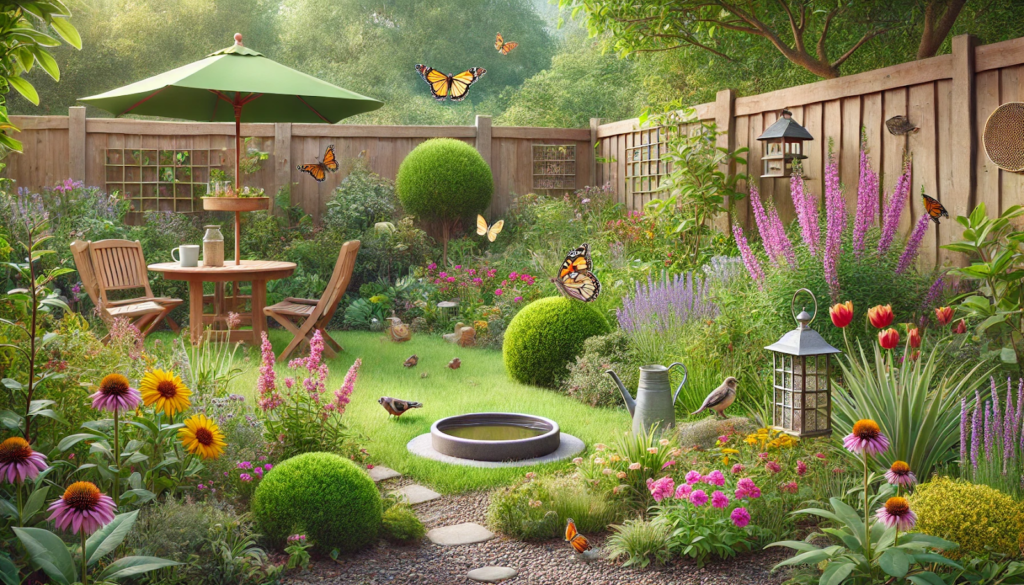A truly thriving garden isn’t just about flowers and vegetables—it’s a living, breathing ecosystem. By designing your garden with wildlife in mind, you’ll create a haven for birds, bees, butterflies, and beneficial insects, all while improving pollination, reducing pests, and supporting the local environment.
This guide shows you how to make your outdoor space more wildlife-friendly, whether you have a sprawling backyard or a cozy patio garden.
Why Support Wildlife in Your Garden?
- Pollination: Attract bees, butterflies, and other pollinators to improve plant productivity
- Natural pest control: Birds and insects help control garden pests naturally
- Biodiversity: Strengthens your garden’s resilience
- Sustainability: Reduces the need for chemical inputs
- Beauty and sound: Enjoy the sights and sounds of nature daily
1. Plant Native Species
Native plants are adapted to your region’s climate and soil and are the best source of food and shelter for local wildlife.
Benefits:
- Require less water and care
- Attract native birds and insects
- Bloom at the right time for local pollinators
Tip: Research native wildflowers, grasses, and shrubs suited to your region.
2. Include a Variety of Plants
Diversity supports more wildlife by offering different food sources and shelter types.
Include:
- Flowering plants (early spring through fall)
- Berry-producing shrubs
- Evergreens and ornamental grasses
- Trees for shade and nesting
Mix plant heights and types to offer layers of habitat.
3. Provide Fresh Water
Wildlife needs clean, reliable water for drinking and bathing.
Water Sources:
- Birdbaths (shallow, with sloped sides)
- Small ponds or water bowls
- Bee watering stations (shallow dish + stones)
Tip: Change water every 2–3 days to avoid mosquitoes and keep it clean.
4. Avoid Pesticides and Chemicals
Chemicals kill more than pests—they harm pollinators, amphibians, and soil microbes.
Alternatives:
- Neem oil, insecticidal soap
- Companion planting for pest control
- Hand-picking pests or using barriers
Let your garden build its own balance over time.
5. Add Shelter and Nesting Sites
Wildlife needs safe places to rest, nest, and hide.
Add:
- Birdhouses and nesting boxes
- Log piles or brush shelters
- Rock or stone piles
- Dense shrubs or tall grasses
Leave some natural debris to mimic forest floor habitats.
6. Create Pollinator Zones
Design areas of your garden specifically for pollinators.
What to Include:
- A mix of nectar-rich flowers (e.g., coneflower, bee balm, lavender)
- Continuous blooming from early spring to late fall
- Avoid double-flowered varieties—they offer less nectar
Group similar plants together for better visibility and feeding.
7. Plant a Butterfly Garden
Butterflies need both nectar and host plants to complete their life cycle.
Butterfly Favorites:
- Milkweed (Monarchs)
- Parsley, dill, fennel (Swallowtails)
- Asters, zinnias, cosmos for nectar
Avoid pesticides completely in butterfly zones.
8. Leave Some Wild Space
Not every corner needs to be perfectly manicured. Wildlife thrives in “messy” areas.
Ideas:
- Let one corner go wild with native growth
- Leave seed heads standing over winter
- Skip fall clean-up to protect overwintering insects
These areas become mini-habitats in your landscape.
9. Attract Birds with Food and Shelter
Birds play a huge role in balancing the ecosystem—and are a joy to watch.
Provide:
- Bird feeders (sunflower seeds, suet, nectar)
- Native berry bushes (elderberry, dogwood)
- Evergreen cover for winter protection
Avoid pesticides, as birds feed on insects and caterpillars.
10. Light Responsibly
Outdoor lighting can disrupt nocturnal wildlife and pollinators.
Light Tips:
- Use motion-sensor lights instead of constant lighting
- Choose warm-colored LED bulbs
- Point lights downward to reduce skyglow
Create dark zones where wildlife can rest undisturbed.
Certify Your Wildlife Garden (Optional)
Several organizations offer certification for wildlife-friendly gardens.
Examples:
- National Wildlife Federation (USA)
- Butterflyway Project (Canada)
- Local conservation agencies
These programs offer signs, guides, and community support.
Bonus: Involve the Family
Wildlife gardening is a great way to connect kids and adults with nature.
Activities:
- Build bug hotels or bee houses
- Keep a birdwatching journal
- Grow plants from seed
- Photograph your garden’s wildlife visitors
A Garden That Gives Back
A wildlife-friendly garden is more than just a collection of plants—it’s a vibrant ecosystem that gives back in beauty, balance, and biodiversity. By welcoming pollinators, birds, and helpful insects into your space, you’ll build a thriving, low-maintenance garden that works in harmony with nature.






